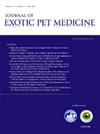The effects of time and anticoagulant type on hematologic values in cockatiels (Nymphicus hollandicus)
IF 0.6
4区 农林科学
Q4 VETERINARY SCIENCES
引用次数: 0
Abstract
Background
Avian hematologic characteristics complicate evaluation; therefore, complete blood cell counts require manual analysis for best accuracy. Furthermore, the quality of samples may be affected by prolonged shipment.
Methods
Blood was collected from the right jugular vein of twenty-four, 7-year-old (14 male, 10 female), wild-type cockatiels (Nymphicus hollandicus). Smears were prepared using fresh, untreated blood. The remainder was divided into dipotassium ethylenediaminetetraacetic acid (EDTA) and lithium heparin microtainers. A hematocrit tube and blood smear were prepared at baseline, 24, 48, and 72 hours after venipuncture. Packed cell volume (PCV), total solids (TS), estimated white blood cell (WBC) count, WBC differential (heterophils, lymphocytes, monocytes, eosinophils, basophils), hemolysis index (HI), and preparation quality were assessed and compared to baseline. After log transformation, the effects of anticoagulants across time points were compared.
Results
Heparinized samples had significant differences in WBC, heterophil, and lymphocyte counts at 48 hours, and PCV and TS at 72 hours compared to baseline. There was a positive proportional bias in PCV and TS from EDTA anticoagulant samples at 24, 48, and 72 hours, and from heparinized samples at 48 and 72 hours compared to baseline. The EDTA samples had increased PCV and TS compared to heparin at all time points, and higher WBC and heterophil counts at 48 hours compared to baseline. A type II methodological error cannot be excluded.
Conclusions and clinical relevance
These results suggest that the anticoagulant used and time spent in anticoagulant alters hematologic values in cockatiels, which may have significant clinical implications. The importance of sample processing within 24 hours and anticoagulant-specific reference intervals for hematologic variables should be considered.
时间和抗凝剂类型对鹦鹉血液学数值的影响
背景鸟类的血液学特征使评估变得复杂;因此,全血细胞计数需要人工分析才能达到最佳准确性。方法从 24 只 7 岁野生型凤头鹦鹉(Nymphicus hollandicus)(14 雄 10 雌)的右颈静脉采集血液。使用未经处理的新鲜血液制备涂片。剩余的血液分别装入乙二胺四乙酸二钾(EDTA)和肝素锂微容器中。在静脉穿刺后的基线、24、48 和 72 小时分别制备血细胞比容试管和血涂片。评估包装细胞体积(PCV)、总固形物(TS)、估计白细胞(WBC)计数、WBC 差异(嗜异性细胞、淋巴细胞、单核细胞、嗜酸性粒细胞、嗜碱性粒细胞)、溶血指数(HI)和制备质量,并与基线进行比较。结果肝素化样本在 48 小时内的白细胞、嗜异性和淋巴细胞计数以及 72 小时内的 PCV 和 TS 与基线相比有显著差异。与基线相比,24、48 和 72 小时 EDTA 抗凝样本的 PCV 和 TS 以及 48 和 72 小时肝素化样本的 PCV 和 TS 存在正比例偏差。在所有时间点,EDTA 样本的 PCV 和 TS 均高于肝素样本,48 小时时白细胞和异性嗜血杆菌计数高于基线值。结论和临床意义这些结果表明,使用的抗凝剂和在抗凝剂中停留的时间会改变凤头鹦鹉的血液学值,这可能会对临床产生重大影响。应考虑在 24 小时内处理样本的重要性以及血液学变量的抗凝剂特定参考区间。
本文章由计算机程序翻译,如有差异,请以英文原文为准。
求助全文
约1分钟内获得全文
求助全文
来源期刊

Journal of Exotic Pet Medicine
农林科学-兽医学
CiteScore
1.20
自引率
0.00%
发文量
65
审稿时长
60 days
期刊介绍:
The Journal of Exotic Pet Medicine provides clinicians with a convenient, comprehensive, "must have" resource to enhance and elevate their expertise with exotic pet medicine. Each issue contains wide ranging peer-reviewed articles that cover many of the current and novel topics important to clinicians caring for exotic pets. Diagnostic challenges, consensus articles and selected review articles are also included to help keep veterinarians up to date on issues affecting their practice. In addition, the Journal of Exotic Pet Medicine serves as the official publication of both the Association of Exotic Mammal Veterinarians (AEMV) and the European Association of Avian Veterinarians (EAAV). The Journal of Exotic Pet Medicine is the most complete resource for practitioners who treat exotic pets.
 求助内容:
求助内容: 应助结果提醒方式:
应助结果提醒方式:


